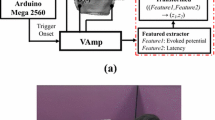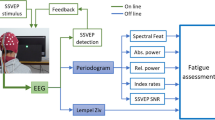Abstract
A brain–computer interface (BCI) using the visual evoked potential (VEP) is being investigated for the use by persons with physical disabilities because it can be input only by looking at the visual stimulus. A transient VEP (TRVEP), which is a type of VEP, is a shape analysis method for synchronous addition during blinking stimuli and was applied only for blinking stimuli below 3.5 Hz. Therefore, in our research, when TRVEP analysis was conducted for high-speed blinking stimuli of ≥3.5 Hz, it was possible to discriminate the blinking stimulus gaze in approximately 2 s at 10 Hz. Furthermore, it has been shown that discrimination can be performed using a lighting interval fluctuation stimulus instead of a regular interval blinking stimulus. This approach currently enables the discrimination of a maximum of eight types of gazes.
In this study, we improved the algorithm in the discrimination of eight options by Electroencephalography (EEG) and investigated the discrimination rate using the correlation coefficient with the sample waveform. As a result, the discrimination rate was lower than that reported in previous studies. One of the factors is that the correlation coefficient decreased because the synchronization phenomenon did not occur. Therefore, it is conceivable to discriminate only the synchronized part instead of the correlation coefficient. There is the possibility that the judgment process can be shortened by narrowing the waveform information utilized for the judgment. In a previous study, discrimination was performed using a coefficient of variation that can simultaneously evaluate the waveform amplitude and standard deviation. These methods will also be examined. In addition, since the blinking control has been improved, we will consider using a stimulus that shifts the phase of the 10 Hz blinking stimulus.
Access this chapter
Tax calculation will be finalised at checkout
Purchases are for personal use only
Similar content being viewed by others
References
Itai, A., Funase, A.: Trial to build BCI system Brain wave analysis technology. J. Jpn. Soc. Neural Circuits 9(3), 118–125 (2012)
Matsuno Shogo, O., Mumu, S.A., Itakura, N., Mizuno, T., Mito, K.: Examination of multi-choice using changes in index lighting interval and brightness in EEG interface using transient type VEP analysis method. IEEJ Trans. Electr. Eng. C 137(4), 616–620 (2017)
Osano, R., Ikai, M., Matsuno, S., Itakura, N., Mizuno, T.: Development of small device for the brain computer interface with transient VEP analysis. In: Proceedings of IEEE Region 10 Conference, pp. 3786–3789 (2016)
Author information
Authors and Affiliations
Corresponding author
Editor information
Editors and Affiliations
Rights and permissions
Copyright information
© 2021 Springer Nature Switzerland AG
About this paper
Cite this paper
Tanaka, S., Mizuno, T., Matsumoto, Y., Mito, K., Itakura, N. (2021). Improvement of Algorithm in Real-Time Brain–Computer Interface. In: Stephanidis, C., Antona, M., Ntoa, S. (eds) HCI International 2021 - Posters. HCII 2021. Communications in Computer and Information Science, vol 1420. Springer, Cham. https://doi.org/10.1007/978-3-030-78642-7_8
Download citation
DOI: https://doi.org/10.1007/978-3-030-78642-7_8
Published:
Publisher Name: Springer, Cham
Print ISBN: 978-3-030-78641-0
Online ISBN: 978-3-030-78642-7
eBook Packages: Computer ScienceComputer Science (R0)




